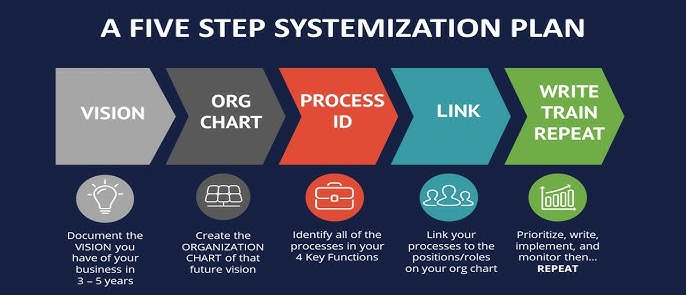Business systemization is a transformative strategy that propels companies toward efficiency, scalability, and ultimately, success.
It involves developing a comprehensive plan to systematize your business operations, a strategy that can significantly increase your company’s value and your personal freedom as a business owner.
We will go over a proven five-step plan for business systemization, ensuring your venture operates smoothly and efficiently without your constant oversight.
Step 1: Vision and Organizational Structure
The foundation of business systemization lies in having a clear vision and an organizational structure that supports this vision. The vision outlines where you want your business to be in the next few years, serving as a beacon for your strategic efforts.
An organizational chart, derived from this vision, delineates roles, responsibilities, and the hierarchy within your company, ensuring clarity and direction for all employees.
Step 2: Process Identification
Identifying key processes is critical to systemization. This involves mapping out all business operations, from lead generation to customer service, and categorizing them into four key functions: getting the business (sales and marketing), doing the business (fulfilling client needs), running the business (administrative and financial operations), and guiding the business (strategic planning and management).
This step requires a meticulous breakdown of each function into specific processes that need to be documented and systematized.
Step 3: Employee Linking and Process Assignment
Once processes are identified, the next step involves linking these processes to specific roles within the organizational chart. This ensures that every task has a designated owner, thereby enhancing accountability and efficiency.
Employees are then trained on these processes, equipping them with the knowledge and tools needed to perform their roles effectively.
Step 4: Writing and Implementing Processes
The creation of detailed process documents is perhaps the most labor-intensive step, but it is also the most rewarding. Prioritizing which processes to document first is key; focus on areas that are critical to your business’s immediate needs or on roles you plan to hire for soon.
Writing processes in simple, understandable language ensures they are easily implementable and adoptable by your team.
Step 5: Continuous Improvement
The final step in business systemization is the ongoing review and improvement of processes. The business environment is dynamic, and your processes should evolve to reflect changes in your operations, industry standards, and technological advancements.
Building a systems-driven culture with regurarly revisiting and refining your processes is key to building a self-managing company.
The Importance of Systemization
A well-systematized business not only operates more efficiently but also becomes more valuable. Processes create consistency in operations, improve quality, and enhance customer satisfaction.
Additionally, systemization prepares your business for scalability, enabling growth without the proportional increase in headaches or resource expenditure. Most importantly, it frees up the business owner’s time, allowing for focus on strategic growth or personal leisure.
Implementing a business systemization plan may seem daunting, but the benefits far outweigh the initial effort. By following these five steps, you lay the groundwork for a business that is not only more manageable and efficient but also more enjoyable to run.
The ultimate reward of business systemization is the freedom it affords you as a business owner – the freedom to focus on growth, innovation, and, most importantly, the freedom to live the life you choos







